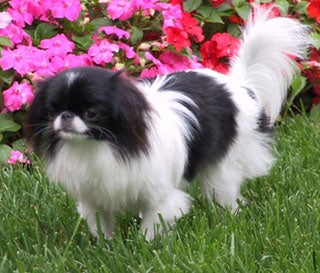Learn about dog breeds
Detailed information & photos on over 190 different breeds
Description
The Japanese Chin is small in size with a soft coat. It is of the spaniel variety. The forehead is round with a wide nose and open nostrils. The nose color matches the coat color. The coat is feathered with a ruff around the neck. The eyes are the most distinguishing feature as they are very prominent and dark. Overall, the head should give the dog an Oriental appearance.
The Japanese Chin has a compact body with straight legs and thin bone structure. They have a high step and are quite noticeable by their walk.
Coat Description
The coat of the Japanese Chin can often reflect the health of the dog, so it is important to know what the standards are for a nice coat. The Japanese Chin has a full coat that is straight. It is a single layer and feels silk like. It stands out slightly from the body and forms a ruff at the neck area.
History
The Japanese Chin has an undefined past. It is thought to date back to 732 AD in Japan. At this time the breed was a part of the royal family. However, some other accounts say the dog originated in China. They were thought to be brought to Europe in the 1600s. The breed is thought to have been brought to America by a naval officer in the 1800s.
Temperament
The Japanese Chin is full of life. It is smart and choosy with its affection. This breed usually becomes attached to its owner, but also is happy to spend time with those it knows well. It can be timid around strangers. They get along well with other dogs and animals. They love to have all the attention on them and will often become distant if ignored or not getting the amount of attention they think they should. As far as toy dog breeds go, the Japanese Chin is well behaved and listens exceptionally.
Health Problems
The Japanese Chin has several health conditions due to its short nose and size. It can often exhibit breathing issues, but some wheezing and snorting is acceptable and not an area for concern. They may also have problems with their knee caps, eyes conditions and other respiratory problems. They can have issues with distemper and endocardiosis. Oral hygiene is also very important to prevent problems with the mouth.
Grooming
The Japanese Chin requires limited care. A daily brushing keeps the coat looking good and free from tangles. This breed rarely has problem with matting de to the single layer coat. They do shed and may need extra brushing during shedding periods. The hair should be brushed in the direction of growth with a slight lift to create volume. Bathing is only done when needed. The eyes and ears should be cleaned daily, as well. Dental care is important and should be done routinely. The nails should be trimmed regularly, too. Keeping the Japanese Chin on a regular daily routine of grooming is important to make him comfortable with the process. The dog should be groomed as a pup to make this easier and more acceptable.
Exercise
The Japanese Chin is not demanding as far as exercise goes. They need relatively little, if any at all, structured exercise. They will usually get the exercise they need on their own. They can benefit from a regular walk, though. The best exercise is indoor play time where they can interact with the family. They may also be taught tricks because they are great learners. In fact, the Japanese Chin is respected for its agility abilities and often trained as a show or competition dog.
Training
The Japanese Chin is a smart breed. They like to make their owner happy and will attempt to do so always. The personality of the Japanese Chin allows it to be easy to train, as opposed to the normal difficulty in training toy breeds. However, despite such pleasing attributes, the Japanese Chin can also be resistant at times and more willing to do what they want than what a trainer wants.
Training should begin as a pup. They will be able to learn basic commands and be housebroken as a pup. Housebreaking is actually pretty easy with this dog since they have a natural tendency to stay clean and want to be clean. Socialization is also important. They need to be introduced to family, especially children and other pets. They are not aggressive, but may withdraw if overwhelmed and not socialized properly as a pup.
The Japanese Chin is often prized for its agility. They do well in shows and learn quickly what is expected of them. They can do simple jumps and follow lines. Agility training can wait until the dog is two years of age.
Advertise | Privacy Policy | Terms of Use | Contact Us © Copyright 2004-2024 PupCity.com. All rights reserved.
